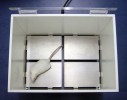Authors
C. Cifuentes-Diaz, S. Nicole, M. E. Velasco, C. Borra-Cebrian, C. Panozzo et al.
Lab
Université d'Evry, GENOPOLE, Institut National de la Santé et de la Recherche Médicale (INSERM), Molecular Neurogenetics Laboratory, Evry, France.
Journal
Human Molecular Genetics
Abstract
Mutations of survival of the motor neuron gene (SMN1) are responsible for spinal muscular atrophy (SMA), a common genetic cause of death in childhood. The cellular mechanism by which mutations of SMN1 are responsible for the selective neuromuscular defect and motor neuron cell degeneration observed in SMA has not been described. We have previously generated mice carrying a homozygous deletion of Smn exon 7 directed to neurons. We report here that these mutant mice display a dramatic and progressive loss of motor axons involving both proximal and terminal regions, in agreement with the skeletal muscle denervation process and disease progression. Moreover, we found massive accumulation of neurofilaments, including phosphorylated forms, in terminal axons of the remaining neuromuscular junctions. This aberrant cytoskeletal organization of synaptic terminals was associated with reduction of branched structures of the postsynaptic apparatus and defect of axonal sprouting in mutant mice. Together, these findings may be responsible for severe motor neuron dysfunction, and suggest that loss of motor neuron cell bodies results from a ‘dying-back’ axonopathy in SMA. Smn mutant mice should represent a valuable model for elucidating the pathway linking Smn to cytoskeletal organization.
BIOSEB Instruments Used:
Aron Test or Four Plates Test (LE830),Rotarod (BX-ROD)

 Pain - Thermal Allodynia / Hyperalgesia
Pain - Thermal Allodynia / Hyperalgesia Pain - Spontaneous Pain - Postural Deficit
Pain - Spontaneous Pain - Postural Deficit Pain - Mechanical Allodynia / Hyperalgesia
Pain - Mechanical Allodynia / Hyperalgesia Learning/Memory - Attention - Addiction
Learning/Memory - Attention - Addiction Physiology & Respiratory Research
Physiology & Respiratory Research
 Pain
Pain Metabolism
Metabolism Motor control
Motor control Neurodegeneration
Neurodegeneration Cross-disciplinary subjects
Cross-disciplinary subjects Muscular system
Muscular system General activity
General activity Mood Disorders
Mood Disorders Other disorders
Other disorders Joints
Joints Central Nervous System (CNS)
Central Nervous System (CNS) Sensory system
Sensory system

